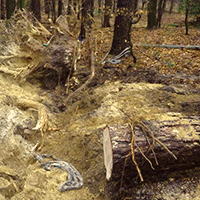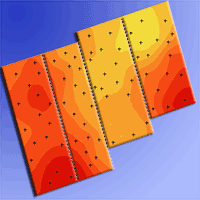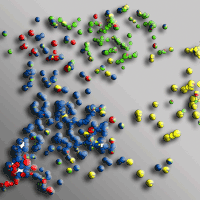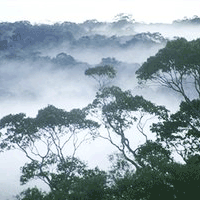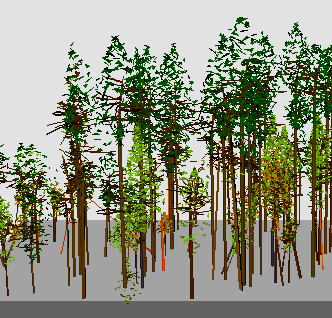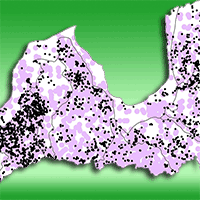
Geographic determinants of spatial patterns of Quercus robur forest stands in Latvia: biophysical conditions and past management
Zigmars Rendenieks (1) , Guntis Brumelis (2), Olgerts Nikodemus (1), Didzis Elferts (2)
iForest - Biogeosciences and Forestry, Volume 12, Issue 4, Pages 349-356 (2019)
doi: https://doi.org/10.3832/ifor2979-012
Published: Jul 05, 2019 - Copyright © 2019 SISEF
Research Articles
Abstract
Most of the forest area dominated by pedunculate oak (Quercus robur L.) in Latvia was lost to arable land several centuries ago and the remnant patches of Q. robur stands are small and spatially scattered. We hypothesized that a large part of the present Q. robur stands in the Eastern Baltic area of the hemiboreal forest zone developed around the past manor houses in the period of social and political turmoil and subsequent agricultural land abandonment. Our aim was to determine the relationship of Q. robur stand occurrence with soil properties, climatic conditions and proximity to past manor houses. Our study area was the entire territory of Latvia (64.589 km2), divided into 16 landscape regions. We used the State Forest Inventory database to filter out all stands dominated by Q. robur (n=3746). Spatial aggregation of the stands was tested by multi-distance spatial clustering analysis (Ripley’s K method). Mean stand area and Euclidean nearest-neighbour distance for stands were calculated for landscape regions. Binary logistic regression with the calculation of autocovariates showed that winter temperature, soil texture, carbonate concentration and distance to closest manor house were the independent factors significantly (p<0.01) related to the probability of occurrence of Q. robur stands. The results showed that Q. robur is spatially clustered, i.e., significantly different from a random distribution (p<0.05). Higher densities of stands occurred in landscape regions with milder maritime climatic conditions. The largest proportional area of stands established between 1885 and 1914 in the period when peasants gained title to lands and manor lords lost control over their land holdings. In addition, in the landscape regions of Rietumkursa, Austrumkursa and Rietumzemgale, the abundance of Q. robur stands coincided with high densities of past manor houses. Thus, establishment of the Q. robur stands likely responded to suitable conditions (open canopy) made available for tree colonization during the land reform occurred 100 years ago. Our results suggest that priority for conservation should be given to spatial aggregations of stands with high connectivity and on richer soils in more maritime conditions.
Keywords
Forest Management, Geographic Distribution, Land Use History, Soil, Manor, Spatial Pattern, Quercus robur
Authors’ Info
Authors’ address
Olgerts Nikodemus 0000-0001-6428-141X
University of Latvia, Faculty of Geography and Earth Sciences, Jelgavas iela 1, Riga, LV-1004 (Latvia)
Didzis Elferts 0000-0002-9401-1231
University of Latvia, Faculty of Biology, Jelgavas iela 1, Riga, LV-1004 (Latvia)
Corresponding author
Paper Info
Citation
Rendenieks Z, Brumelis G, Nikodemus O, Elferts D (2019). Geographic determinants of spatial patterns of Quercus robur forest stands in Latvia: biophysical conditions and past management. iForest 12: 349-356. - doi: 10.3832/ifor2979-012
Academic Editor
Chris Eastaugh
Paper history
Received: Oct 21, 2018
Accepted: Apr 10, 2019
First online: Jul 05, 2019
Publication Date: Aug 31, 2019
Publication Time: 2.87 months
Copyright Information
© SISEF - The Italian Society of Silviculture and Forest Ecology 2019
Open Access
This article is distributed under the terms of the Creative Commons Attribution-Non Commercial 4.0 International (https://creativecommons.org/licenses/by-nc/4.0/), which permits unrestricted use, distribution, and reproduction in any medium, provided you give appropriate credit to the original author(s) and the source, provide a link to the Creative Commons license, and indicate if changes were made.
Web Metrics
Breakdown by View Type
Article Usage
Total Article Views: 43558
(from publication date up to now)
Breakdown by View Type
HTML Page Views: 37138
Abstract Page Views: 2960
PDF Downloads: 2717
Citation/Reference Downloads: 3
XML Downloads: 740
Web Metrics
Days since publication: 2353
Overall contacts: 43558
Avg. contacts per week: 129.58
Citation Metrics
Article Citations
Article citations are based on data periodically collected from the Clarivate Web of Science web site
(last update: Mar 2025)
(No citations were found up to date. Please come back later)
Publication Metrics
by Dimensions ©
Articles citing this article
List of the papers citing this article based on CrossRef Cited-by.
References
Zeme, zemnieks un zemkopiba Latvija: no senakiem laikiem lidz musdienam [The land, peasant and agriculture in Latvia. From early times till the present day]. Latvijas Lauksaimniecibas Universitate, Jelgava, Latvia, pp. 717. [in Latvian]
Gscholar
Okeaniskas un kontinentalas gaisa masas Latvija [Oceanic and continental air masses over Latvia]. Latvijas Vegetacija 14: 109. [in Latvian]
Gscholar
Quercus robur and Quercus petraea in Europe: distribution, habitat, usage and threats. In: “European Atlas of Forest Tree Species” (San-Miguel-Ayanz J, De Rigo D, Caudullo G, Houston Durrant T, Mauri A eds). Publication Office of the European Union, Luxembourg, pp. 160-163.
CrossRef | Gscholar
Legacies of the past in the present-day forest biodiversity: a review of past land-use effects on forest plant species composition and diversity. In: “Sustainability and Diversity of Forest Ecosystems” (Nakashizuka T ed). Springer, Tokyo, Japan, pp. 361-371.
CrossRef | Gscholar
Ozols (Quercus robur) Kurzeme [Oak (Quercus robur) in Kurzeme]. Mežsaimniecibas Rakstu Krajums (14): 41-81. [in Latvian]
Gscholar
Boreala un nemorala bioma kokaugu sugu regionala izplatiba Latvija [Regional distribution of boreal and nemoral biome woody plants in Latvia]. Doctoral dissertation, University of Latvia, Riga, Latvia, pp. 128. [in Latvian]
Gscholar
Geochemical map of Latvia. Valsts Geologijas Dienests, Riga, Latvia. [in Latvian]
Gscholar
Map of Quaternary sediments in Latvia. Latvijas Valsts Geologijas Dienests, Riga, Latvia. [in Latvian] [CD-ROM]
Gscholar
Detecting interspecific and geographic differentiation patterns in two interfertile oak species (Quercus petraea (Matt.) Liebl. and Q. robur L.) using small sets of microsatellite markers. Forest Ecology and Management 259(10): 2026-2035.
CrossRef | Gscholar
Latvija. Zeme, daba, tauta, valsts [Latvia. Land, nature, people, state]. Latvijas Universitates Akademiskais apgads, Riga, Latvia, pp. 752. [in Latvian]
Gscholar
Feodalo lauksaimniecibas zemju izvietojuma galvenie fiziogeografiskie faktori un to sakars ar musdienu ainavu [Main factors for location of feudal agricultural lands and their relation to present landscape]. In: “Latvijas PSR geografiskie kompleksi un cilveks” [Geographical complexes and people of Latvian SSR] (Ramans K ed). P. Stučkas Latvijas Valsts Universitate, Riga, Latvia, pp. 120. [in Latvian]
Gscholar
Ainavu rajonešana [Landscape zoning]. In: “Latvijas Daba 1” [Nature of Latvia Vol. 1] (Kavacs G ed). Latvijas enciklopedija, Riga, Latvia, pp. 186-188. [in Latvian]
Gscholar
Rothmaler: Exkursionsflora von Deutschland. Gefäßpflanzen: Kritischer Band [Rothmaler: excursion flora of Germany. Vascular plants: critical volume]. Spektrum Akademischer Verlag, Berlin, Germany, pp. 811. [in German]
Gscholar
Amphi-Atlandic zonation, nemoral to Arctic. In: Proceedings of the Symposium “North Atlantic Biota and their History” (Löve A, Löve D eds). University of Iceland, Reijkijavik (Iceland) 1962. Pergamon Press, Oxford, UK, pp. 109-125.
Gscholar
Latvijas mežu politika un likumdošana (XI gs. - 1940.g.) [Latvian forest policy and normative regulation (XI century - 1940)]. In: “Latvijas Meža Vesture Lidz 1940. Gadam” [The History of Forests in Latvia until 1940] (Strods H ed). WWF Latvia, Riga, Latvia, pp. 12-107. [in Latvian]
Gscholar
Latvijas vesture 1800-1914 [History of Latvia 1800-1914]. Daugava, Riga, Latvia, pp. 752. [in Latvian]
Gscholar
Latvijas valsts mežu apsaimniekošana 1918-1940 [The management of state forest in Latvia from 1918 till 1940]. Nacionalais Apgads, Riga, Latvia, pp. 430. [in Latvian]
Gscholar
Mežainuma un koku sugu sastava parmainu dinamika un to galvenie ietekmejošie faktori Latvijas teritorija. In: “Latvijas Meža Vesture Lidz 1940. Gadam” [The History of Forests in Latvia until 1940] (Strods H ed). WWF Latvia, Riga, Latvia, pp. 111-206. [in Latvian].
Gscholar


